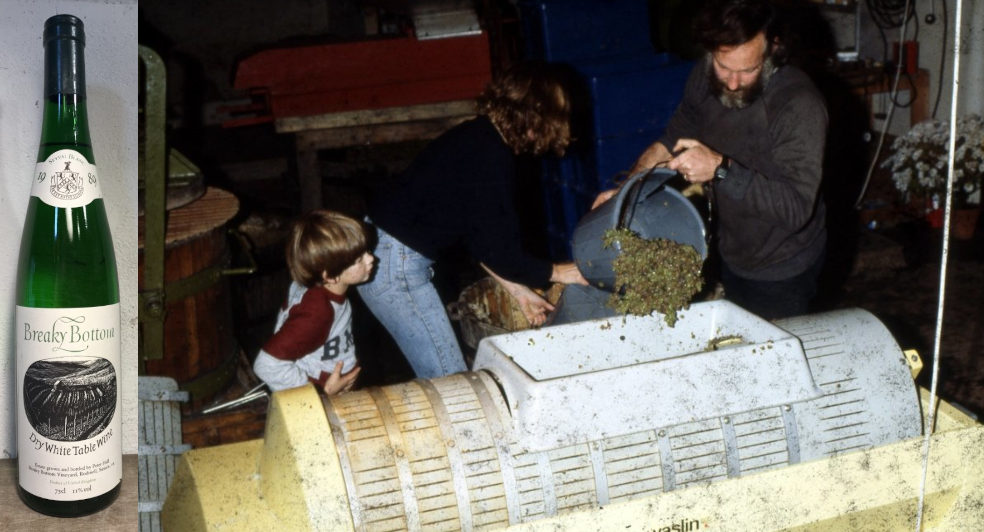Breaky Bottom – Peter’s Notes, June 2024
17th July 2024

As I start on Peter’s Notes for June, already rather late in the month because of the pressing work required in the vineyard for the 2024 crop, I am still looking to think back to the early days soon after planting. The photographs I choose will be rather higgledy-piggledy, but they are ‘of-the-time’ – my first attempts at winemaking, sweet memories of a long time ago.
The Sussex flint barn, dated 1827, was to become the winery. I had no money to buy any equipment so my first harvest in 1976 had to be sent for processing to Lamberhurst, then the largest UK vineyard at 50 acres. Nevertheless, I was determined to vinify a small portion of this crop. I put the grapes into a large bucket and fashioned a primitive grape crusher from a broomstick and a heavy lump of seasoned applewood. I bought a tiny hand-press to extract the juice and fermented this in small oak barrels. I recall the wine being palatable, a decent ‘first attempt’.
My wine chemist friend Mark Russell used to travel the world checking the provenance of huge tanker-loads of wine before they were imported into Shoreham. This business had just come to an abrupt end as countries like Chile and Argentina learnt the extra value of bottling in the country of origin. Mark encouraged me to buy large fibre-glass tanks at something like £40 each! I bought six of these, some at 5,000lts, others at 2,500lts.
By 1977-8 I was able to acquire a little more equipment. This was the start of twenty years or so of my still winemaking days. For still wines whole grapes need to not only be crushed but de-stemmed to minimise any bitter stalky taste. We used wonderful old French half-barrels to catch the pulp.
I was fortunate when a friend offered me an ancient German winepress that he no longer required which was already over 100 years old – it would have been worth a fair bit, but I recall the seller loving the Breaky Bottom wines I had already made, and he was happy to settle with a few boxes! It’s an amazing piece of equipment and did a great job. It’s worth noting that today, as a sparkling winemaker, the 1.25 tonne press I use now is specifically designed for the job – the grapes are whole-bunch pressed, and pressed very lightly, programmed to only extract a finite juice volume per ton of fruit. After pressing the ‘waste’ pomace is stacked outside, and after a couple of years or more is returned to the vineyard to enrich the soil’s physical and chemical structure. In my still winemaking days this pomace was as dry as a bone, pressed very hard and extracting flavours from the grape skins to enhance the still wine – with my current sparkling winemaking, the pomace remains moist with sweet-tasting juice!
But I soon discovered I needed a bigger press to deal with the size of harvest as my little basket press could not cope – the speed of processing is important to maintain the quality of juice, whether for still wine or sparkling. Grapes must be pressed on the day of picking. I acquired a modest sized Vaslin press around 1980, and although small when compared with larger vineyards in the UK, it was real progress.
To complete the necessary equipment needed to bottle the wine I bought a corking machine and one to spin on the capsules – the top-quality branded corks came from Portugal and the bottles from AE Chapman, London.
As footnote for the June Notes it’s appropriate to display a bottle, the finished article! Here it is 35 years on, with the original Reynolds Stone label, complete with the engraved vignette of the vineyard.
With all best wishes from the Breaky Bottom Team, Peter & Christina
![]()
Peter Hall
Peter has had 50 years of making wine at Breaky Bottom. He has come to appreciate that the best wine is made in the vineyard. The winemaker’s job is to let good grapes express themselves naturally.
